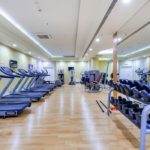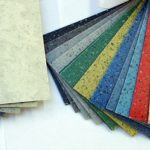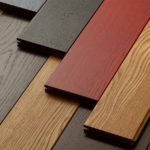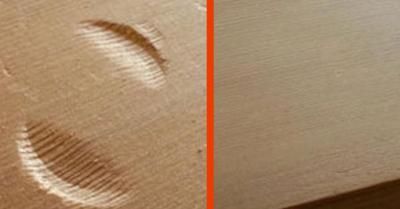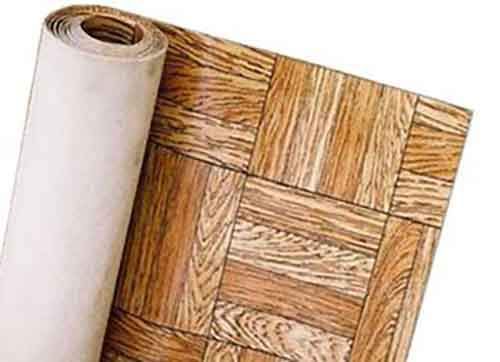Laying commercial linoleum
Despite the emergence of new types of flooring in recent years, linoleum continues to be one of the most popular materials. According to the area of application, it is divided into two main types:
- Domestic.
- Commercial.
The household variety is intended for use in residential premises where mechanical loads on the floors are relatively low. This type of linoleum consists of several layers - a base of PVC or polyester, coated with compacted polyurethane with a pattern applied to it. The top of the polyurethane is often covered with a protective film. The service life of such material does not exceed 10–15 years.
Commercial linoleum, unlike household linoleum, is designed for much larger loads. Its main area of application is public buildings: educational and administrative institutions, cinemas and shopping centers. Since in such places the load on the flooring is many times higher than in residential apartments, commercial varieties are subject to increased requirements regarding their resistance to abrasion and other mechanical damage. The service life of commercial modifications of linoleum coverings exceeds 20-30 years. However, their cost is also higher than that of household varieties, and installation requires compliance with a number of special technological conditions.
Attention! The main feature of commercial floor coverings is their fire resistance, high resistance to chemical detergents and all kinds of contamination.Therefore, for finishing floors in public places, it is more expedient and more economical to purchase more expensive, but more resistant options.
The content of the article
How to properly lay commercial linoleum
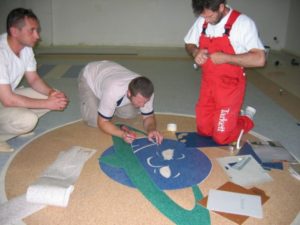 There are two technologies for laying commercial linoleum:
There are two technologies for laying commercial linoleum:
- With a bend on the walls, when the edges of the covering extend onto the walls in the form of a low side.
- Under the baseboard - the edge of the covering lies without bending, at some distance from the wall. The gap on top is covered with a decorative plinth.
Regardless of which option you choose, a number of technological nuances must be observed when working. Before direct installation, both the base of the floors and the laying material must undergo special preparation.
Floor preparation
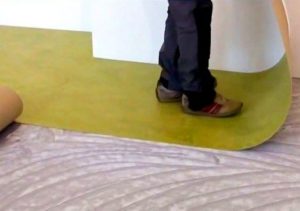 Linoleum is a very thin and flexible material, so it will not be able to hide all the defects and unevenness of the floor. And varieties with a geometric pattern, on the contrary, will highlight all the defects of the base. To prevent this from happening, you will first need to carefully level the floors. Concrete bases are easiest to level using self-leveling floors - special liquid solutions that polymerize when exposed to air. Due to its fluid consistency, after application to the surface of the floors, they spontaneously level out, forming a perfectly smooth surface.
Linoleum is a very thin and flexible material, so it will not be able to hide all the defects and unevenness of the floor. And varieties with a geometric pattern, on the contrary, will highlight all the defects of the base. To prevent this from happening, you will first need to carefully level the floors. Concrete bases are easiest to level using self-leveling floors - special liquid solutions that polymerize when exposed to air. Due to its fluid consistency, after application to the surface of the floors, they spontaneously level out, forming a perfectly smooth surface.
A more budget-friendly option for leveling concrete floors is to clean up protruding irregularities using a grinder. Potholes and chips are covered with cement mortar or a special putty for concrete.Wooden floors should be leveled by laying sheets of plywood, chipboard, or OSB (oriented strand board) joint to joint. After this, it is recommended to treat them with antiseptic and water-repellent compounds to avoid fungal damage.
An important part of the preparatory work consists of treating the floor surface with primer solutions. Primer compositions are intended to increase the adhesion of materials. Adhesion refers to the interpenetration of particles of different substances, for example, paint or glue, into the surface of the wall. Primer treatment significantly increases the strength of the connection between the base and floor materials.
Attention! There are many options for primer compositions on the modern market, each of which is intended for specific surfaces. Therefore, for concrete floors you should buy only a primer for concrete, and for plywood floors - primer compositions for wood.
Laying commercial linoleum occurs after the primer is applied to surfaces previously cleaned of dust and dirt using a brush or roller, in 2-3 layers. Each subsequent layer is applied only after the previous one has completely dried.
Preparation of linoleum
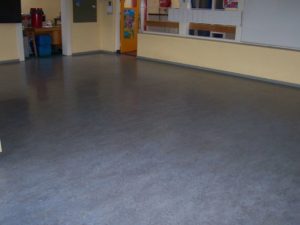 The room where you are going to work must have a constant positive temperature, around +15...20OC, and humidity is about 40–50%. These are ideal conditions for finishing work in general, and for laying floor coverings in particular. Due to its increased rigidity, commercial linoleum is less flexible and more prone to cracking when forced to deform. Therefore, when working with it, you should be careful.
The room where you are going to work must have a constant positive temperature, around +15...20OC, and humidity is about 40–50%. These are ideal conditions for finishing work in general, and for laying floor coverings in particular. Due to its increased rigidity, commercial linoleum is less flexible and more prone to cracking when forced to deform. Therefore, when working with it, you should be careful.
Before starting installation, it is recommended to bring the purchased material into the room and leave it at least overnight. This is necessary so that it accepts the temperature of the room: after laying, the material will no longer change its volume and deform. In order for the sheets to expand as much as possible, the rolls should be rolled out and left in this state.
Laying the material
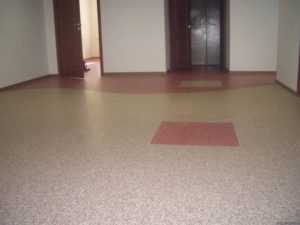 To fix linoleum coverings, three methods of attachment to floors are used:
To fix linoleum coverings, three methods of attachment to floors are used:
- On double-sided adhesive tape.
- Special adhesive solution.
- Floating - involves laying “dry”, with fixation only by wall skirting boards.
When working with large volumes, glue is usually used. Adhesive tape and the “dry” version are used in small spaces. The floating option is also often used when laying ordinary household linoleum. Using double-sided construction tape will further secure the coating to the base of the floor.
Laying should begin from the corner of the room located further from the door. Initially, the rolled sheet is cut along the length of the room. If you decide to use the folded option, you should add an overlap to the walls (usually about 5 cm) to the length and width of the sheet. This option will allow you to avoid installing decorative skirting boards around the perimeter of the walls. When choosing a technology for laying without bending, under the baseboard, you should cut the sheets so that they do not lie flush against the wall, but there is a gap of 5 mm between them. This gap, also called a damper seam, will subsequently be closed with a plinth and will be completely invisible from the outside.
Attention! Damper seams are necessary to compensate for thermal expansion of the material.For example, in the summer, when the temperature rises, the linoleum sheets will expand, and when laid close to the wall, they will begin to deform. If there is some gap between the linoleum covering and the wall, such a problem can be avoided.
If linoleum is laid on an adhesive compound, then the base is coated with a brush or roller, after which a pre-prepared piece of linoleum is laid on it. Using a wide spatula, the glued section is carefully smoothed out, and air bubbles are removed from under it. To obtain the tightest possible joints, individual sheets are laid on top of each other with a slight overlap of 2-3 cm. Then, using a metal meter and a sharp knife, we make a through cut along the edge of the joint.
The knife should cut through both sheets, resulting in a perfectly thin joining seam. To further seal the seam, use a special soldering iron with a fusible cord. Melting, the cord fills the joint, making it airtight and almost invisible from the outside. In the absence of such a tool, the joining seams can be sealed with the same adhesive solution that was used for gluing linoleum.
Is it possible to lay commercial linoleum in an apartment?
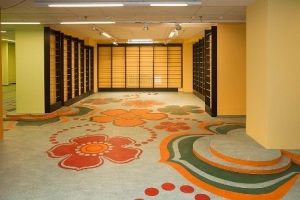 Is it possible to lay commercial linoleum in an apartment? In addition to public buildings, commercial linoleum coating can also be used in residential premises. Due to its resistance to external influences, it is perfect for rooms with high mechanical loads and high traffic volumes - in the hallway, kitchen, balcony.
Is it possible to lay commercial linoleum in an apartment? In addition to public buildings, commercial linoleum coating can also be used in residential premises. Due to its resistance to external influences, it is perfect for rooms with high mechanical loads and high traffic volumes - in the hallway, kitchen, balcony.
You can lay commercial linoleum in a private apartment using any of the methods listed above.When choosing this option, each homeowner is based on considerations of financial feasibility: is it better to use a more expensive, but also more durable commercial type for a residential space, or get by with a budget household linoleum covering.

